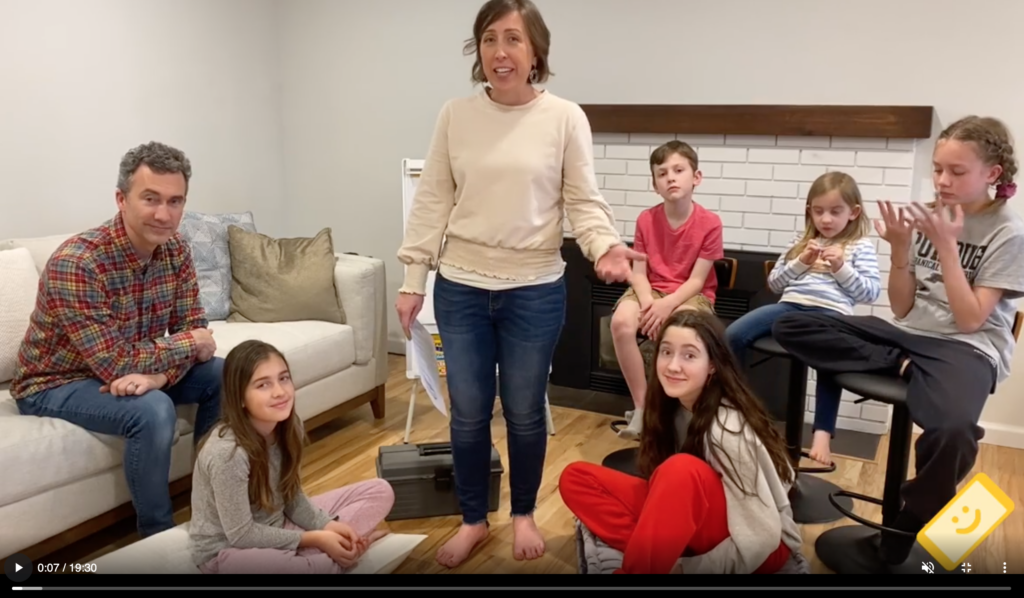We’re the family who kept the TV in the closet for over a decade; pulling it out only for the Olympics and family movie nights. Tyler and I were on a quest to raise readers, and to encourage creativity, learning, and time outdoors for our kids.
But…a lot has changed since 2005 when we first became parents. Technology has evolved and morphed into MUCH more than television. We now carry mini-computers in our pockets, and we have a teenager!
We made the mistake of handing over a smartphone too soon to our (then) middle schooler. Red flags started popping up: scrolling, strange apps, and even worse—strangers. We backtracked, said goodbye to the smartphone, and handed over the dreaded brick phone instead.[1]
While painful, it was one of the best parenting decisions we’ve ever made. We learned that the internet was not designed with kids in mind. Until something changes, it’s up to us as parents to keep kids safe online.
Bubble Wrap
We believe in wrapping our kids in bubble wrap and protecting our kids as much as possible. We’ve learned how to be countercultural in many ways—delaying smartphones, social media, and gaming. And we aren’t the only ones.

By delaying access to devices that use persuasive design (they keep us hooked!), for kids whose prefrontal cortex (decision-making part of the brain) is not yet fully developed, we’re allowing our kids to grow up free from the digital heaviness that is quickly destroying childhood, one kid at a time.
Kids might feel like they are missing out without smartphones or TikTok, but by delaying access to devices and apps, we increase the chances that they avoid all these negatives:
- Anxiety
- Depression
- Comparison
- Cyberbullying
- Pornography
- Online predators
- Self-harm misinformation
- Fatal online challenges
And really, so much more. According to a 2018 study shared by the American Psychological Association,
“Adolescents who spent more time on electronic communication and screens (e.g., social media, the Internet, texting, gaming) and less time on non screen activities (e.g., in-person social interaction, sports/exercise, homework, attending religious services) had lower psychological well-being.”
Considering the fact that the U.S. Surgeon General recently issued an advisory on youth mental health, we all need to do our part to protect our kids’ psychological well-being and that includes saying the words, “not yet” to requests for devices and apps.
We are committed to protecting our kids, but we’ve learned that bubble wrap will only take us so far. There are screens everywhere now.
Our kids need preparation, not just prevention.
Enter Battle Prep
We started engaging in conversations with our kids about technology and the role it plays in our lives five years ago. We now simply call them “Tech Talks.”
These Tech Talks led us to create a family tech plan with our kids. You can create your own family tech plan with our Quick Guide here.
We then talked about cyberbullying, pornography, spending time wisely, video games, video streaming, online safety, values, family culture, and when a personal device will be appropriate and what that process would look like.
You’ll find all of those conversations in our discussion guide, Creating a Tech-Healthy Family: Ten Must-Have Conversations to Help You Worry Less and Connect More with Your Kids.
You can even watch our family modeling the first discussion in the book right here. (We had just moved back into our home after our house fire, so please excuse the bare walls!)

Two Types of Tech Talks
We utilize two types of Tech Talks in the Davis home. Chances are you’ve used these two strategies in your home, too, perhaps without really thinking about it.
- Family Group Tech Talk
- Individual One-on-One Tech Talk
The Essential Family Group Tech Talk
The first type of Tech Talk includes your entire family. This talk is essential and foundational, and will make all future conversations and decisions about technology much easier!
In a family group discussion you can make decisions as a family about:
- Where to use screens, how long to use them, what they should be used for, and who with. (This is your Family Tech Plan.)
- Your family’s values.
- What online activities and content are appropriate according to your family’s values.
- How to support one another in learning and living healthy screen habits.
- Your family’s “why” and deciding how to use technology so relationships come first.
Taking time to have these conversations will save you SO much time and from pulling your hair out in frustration. By making decisions together, your kids understand the expectations and you don’t have to be the mean parent!
We walk parents through the process from beginning to end in our course, Creating a Tech-Healthy Family: Reduce Screen Time. Restore Family Time. Raise Kids Who Thrive.
We quickly learned that healthy tech habits start with us as parents. Our course helps parents first, and then parents turn their focus to teaching their kids and preparing them for life in a digital world. You can learn more about the course here.
The Life-Saving Individual One-on-One Tech Talk
While the family group tech talks are essential, I would argue that the individual one-on-one talks are life-saving.
Typically you will start having more of these talks when your kids are around 8–9 years old. Developmentally, kids start to think logically and at this age, yet the family is still central to the child’s life. It’s a great time to start talking about important topics!

In a one-on-one discussion you have the opportunity to have private conversations about:
- Your child’s online life. What have they seen?
- What their friends are doing online and offline.
- Their mental health.
- Their worries, stressors, and concerns.
- The harmful effects of pornography and how to avoid it and/or walk away.
- Their questions about their body, sex, life, and relationships.
- How they are balancing their time online and their overall wellbeing.
- Sleep and study habits.
- Their personal values that will guide their choices online and offline.
Once you start having these Tech Talks with your older kids and teens, an incredible thing happens…they eventually start talking about other things going on in their lives. It’s a beautiful process to watch unfold. I’ve experienced this, and have heard the same from many parents in the Better Screen Time Community.
There’s no reason to stay tied to talking about tech during Tech Talks. Our lives are multi-faceted, and our kids’ offline lives and online lives are all meshed together. When we show up and listen, we learn so much from our child, and can get inspiration on how we might better help them in areas where they might be struggling.
We help parents work with their teens, ages 12–17, to identify values, create a parent/teen pledge, and have all kinds of one-on-one tech talks in our course, Untangling Teens & Tech.
While it’s easiest when these conversations just naturally come up, that’s been challenging at times with five children. We’ve found that we often have to schedule these talks in order to make them happen!
Why Battle Prep & Bubble Wrap Matter
These two types of Tech Talks are powerful tools that help your kids understand why you are bubble wrapping them as much as possible. This is going to help when they come home and say, “I’m the only one in my whole grade who….” (doesn’t have a smartphone, doesn’t have Snapchat, etc.). While it will still be hard, if they know why you aren’t allowing those things yet, they’ll understand you are coming from a place of love, not control.
As Dr. Meg Meeker says, we want to parent from a place of confidence and not fear. These Tech Talks will help you do just that.
Tech Talks also help us as parents instill and teach values so our kids will make good choices even when we’re not right by their side. It is an opportunity to prepare them for the digital battles ahead!
How Do I Get My Kids on Board?
Many parents tell me, “my kids will never go for that” or “I get lots of eye-rolls or bored looks.” Believe me, I’ve been there. Power through, friends!

Here are some tips to help:
- A little pushback from our kids is okay, but if anyone is losing their patience (including you), pause and try again another day.
- Get out the ice cream or a favorite family treat and gather around the kitchen table. This doesn’t have to be painful.
- Give your kids responsibilities: scribe (write down what was discussed), let someone else pick a playlist for background music sans vocals, someone else can light a candle, one person can get out the treats. It might not be fun, but it can be enjoyable.
- Let your kids draw or doodle as you talk.
- A walk or driving a child to an activity is a great opportunity for one-on-one talks. Sometimes no eye contact is nice for older kids and teens!
- Schedule it on the calendar and let everyone know ahead of time. Let your kids set a time and agree that if everyone listens and helps, you’ll finish in 20 minutes and go do an activity together (game, bike ride, etc.). We’ve found Sunday evenings to be a good time for our family tech talks and individual tech talks. (Just not both on the same night.)
Protect and Prepare, Parents!
Dear parents, delay giving your kids a personal device as long as possible, but don’t delay teaching your kids. Teach them starting now—and always nurture the relationship first. Utilize these two types of Tech Talks—let them be your bubble wrap and battle prep. Bind your kids in bubble wrap when possible, but also prepare them for the battle of digital dangers that lie ahead.
[1] Today we have many more device options than we did 5 years ago. Older kids and teens can start with a Gabb Phone (you can use the code BST for a great discount—we are affiliates) which has no internet connection or app store. As kids get older they can graduate to a Pinwheel or Troomi phone, which gives parents options to allow approved apps, and still stay off social media until kids are older and ready.
